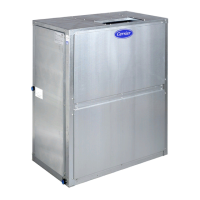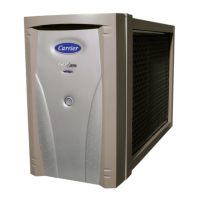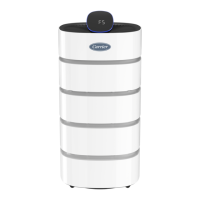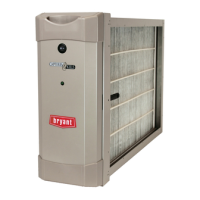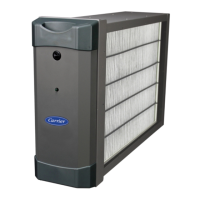ERV & HRV: User and Installer Manual
Manufacturer reserves the right to change, at any time, specifications and designs without notice and without obligations.
10
Electrical Connection to Dry Contact Optional Auxiliary
Wall Control (Crank Timer)
A210070
CONNECTION TO THE CENTRAL FORCED-AIR
SYSTEM
Unit Operation Using a Dry Contact Connection
This unit can be controlled by any dry contact connection such as the
thermostat equipped with an optional ventilation output (Fig. 16).
Once wired, unit will toggle between the Standby mode when contact is
opened and the selected mode when contact is closed. Choose among
these 4 configurations in DRY option on the LCD screen when the
VENT contact is activated:
• minimum (unit operating in MIN speed)
• intermittent (unit operating in MIN speed 20 min/hr then as per INT
configuration selection for 40 min)
• auto* (unit operating according to outdoor temperature)
• maximum (unit operating in MAX speed)
Refer to (NAVIGATION ON LCD SCREEN on p14) for more details.
* In auto mode, the unit will operate as follows:
• Less than -25°C = 10 min/hr
• -25°C to -7°C = 20 min/hr
• -7°C to 10°C = 40 min/hr
• 10°C to 25°C = MIN speed
• 25°C to 28°C = 30 min/hr
• 28°C to 33°C = 20 min/hr
• Above 33°C = 10 min/hr
NOTE: In this configuration do not use a separate ERV/HRV wall
control.
A210072
Fig. 16 – Wiring for Dry Contact Connection
A2010073
Fig. 17 – Alternate Wiring for Dry Contact
Independent Installation (T-1)
NOTE: This dry contact option will override the main wall control, so
we do not recommend the use of a wall control with this type
connection.
NOTE: Following ducting installation configuration and temperature
conditions, it may be necessary for the unit to operate continuously.
Refer to (INSTALLING THE DUCTWORK AND THE REGISTERS
on p5) for more details.
CAUTION
!
UNIT DAMAGE HAZARD
Failure to follow this caution may result in equipment
damage.
A miswiring that sends a 24VAC signal to the 6-position terminal block
(OVR, LED, 12V, D-, D+, GND) could permanently damage the
control circuit. Verify the wire connections carefully before powering
up the unit.
CAUTION
!
UNIT DAMAGE HAZARD
Failure to follow this caution may result in equipment
damage or improper operation.
Never connect a 120V AC circuit to the terminals of the central
forced-air system interlock (standard wiring). Only use the low voltage
class 2 circuit of the central forced-air system blower control. The unit
is designed for low voltages only. Connecting the unit to 120V would
damage it instantly.
Crank Timer
or any
Dry Contact
OVR 12V
Y
W
C
Gf
G
R
D
-
D+
GND
Air Exchanger
Terminal Blocks
J13
Vent
J9
OVR
LED
12V
Central Forced Air System Thermostat
Y W G RC Acc+ Acc-1
Y
W
C
G
R
Central Forced Air System
1 - External switch or any dry contact can be used to activate
vent input if not available on the thermostat. Some
thermostats offer a single-wire 24VAC outut for accessory
ventilation. It can be directly connected to the vent input
and therefore the Acc- / R connection is not required.
Air Exchanger
Terminal
Blocks
J13
External Switch or any
alternate Dry-Contact
J9
OVR
LED
12V
-
D+
GND
Vent
Gf
Note: Synchronization with a central forced-air system with W and Y
is not available with this configuration.
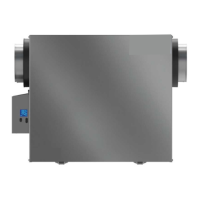
